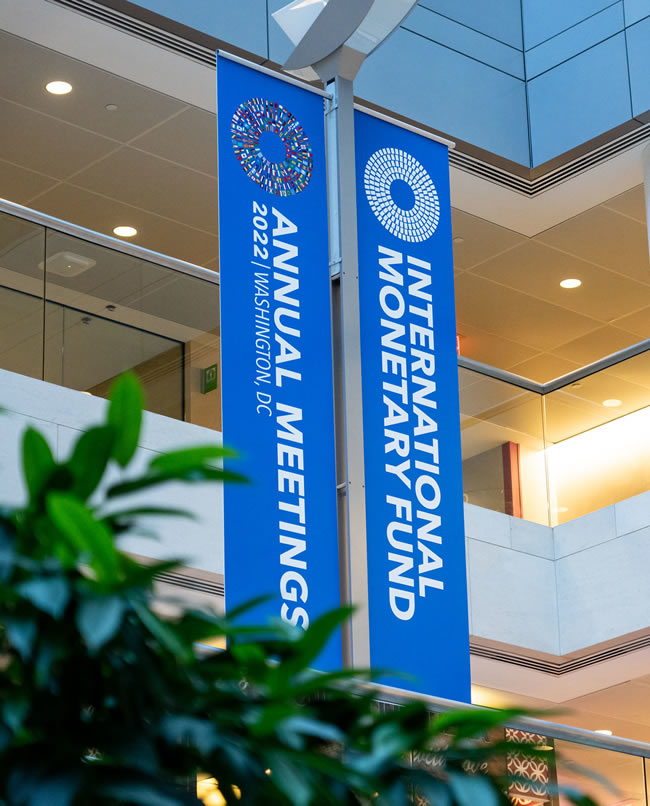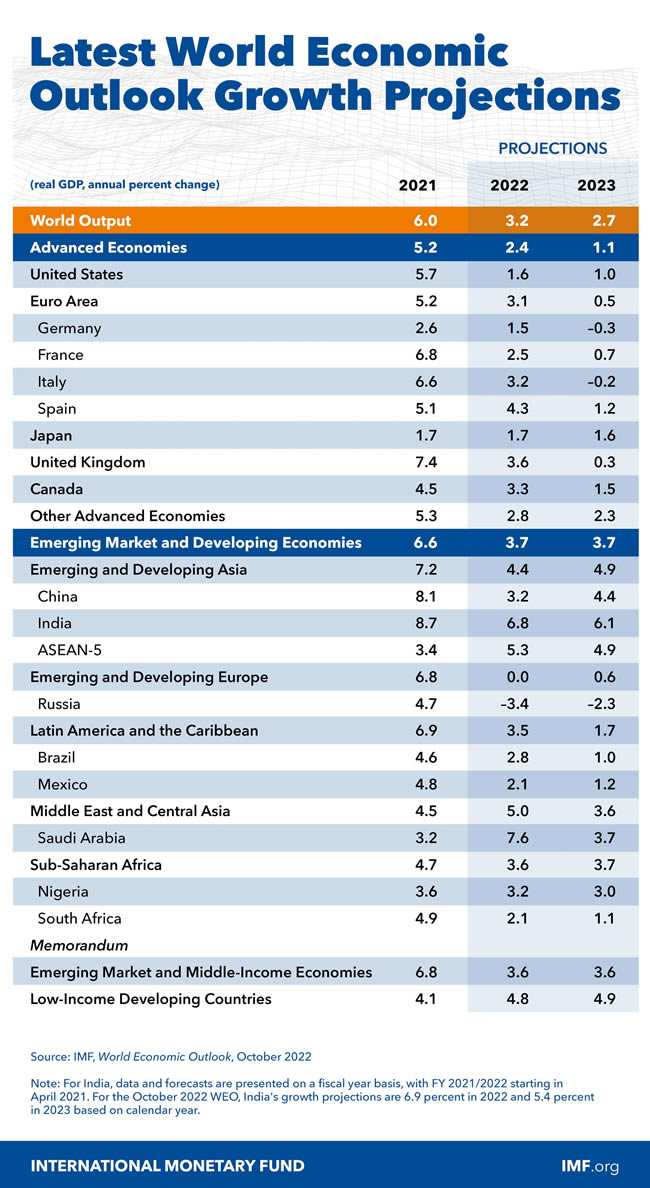« "Peace Monument" sculpture in the Garden of UN Headquarters, New York | Main | Times Higher Education announces World University Rankings 2023 »
October 11, 2022
IMF releases World Economic Outlook Report October 2022

Photo: Behinds the scenes during the 2022 Annual Meetings at the International Monetary Fund. Washington, DC, United States. October 10, 2022. IMF Photo/STEPHEN VOSS.

Photo: IMF Managing Director Kristalina Georgieva participates in a meeting at the Global Center on Adaptation. Rotterdam, Netherlands. September 5, 2022. IMF Photo/Eric Kampherbeek.
Washington, October 11, 2022 — The IMF projects global growth is slowing under the burden of high inflation, the impact of Russia’s war in Ukraine, and the lingering effects of the pandemic, announced Pierre-Olivier Gourinchas, the IMF’s Chief Economist on Tuesday, October 11 in Washington, DC.
The Fund expects global growth to remain unchanged in 2022 at 3.2 percent and to slow down to 2.7 percent in 2023—0.2 percentage points lower than the July forecast—with a 25 percent probability that it could fall below 2 percent.
“The global economy is weakening further and facing a fragile environment. The outlook continues to be shaped by three forces. Persistent and broadening inflation, causing a cost-of-living crisis, the Russian invasion of Ukraine and the associated energy crisis, and the economic slowdown in China. This year’s projection for world GDP growth is unchanged at 3.2%, as in the July World Economic Outlook update. Global growth is forecast to slow to 2.7% in 2023, 0.2 percentage points lower than projected in July. The slowdown is broad-based. More than a third of the global economy will contract in 2023, while the three largest economies in the world, the United States, the Euro area, and China, will continue to stall. For the first time, we calculated risks around the baseline projections. We find there is a 25% chance that growth will fall below 2% in 2023. It happened exceedingly rarely in the past, and a 10 to 15% chance it will fall below 1%, corresponding to a decline in real output per capita,” said Gourinchas.

Downside risks remain elevated, while policy trade-offs to address the cost-of-living crisis have become acutely challenging. Moreover, monetary, fiscal, or financial policy miscalibration risk has risen sharply when the world economy remains historically fragile and economic markets show signs of stress.
Gourinchas explained that, unfortunately, most risks to the outlook are to the downside:
- Monetary policy miscalibration is risky during high uncertainty and fragility. In particular, we are concerned that central banks will ease too early, causing inflation to remain excessively high and requiring a much more significant loss of output later.
- A persistently strong dollar could fuel inflation and amplify financial tightening, especially in emerging markets and developing economies.
- High post-pandemic debts and higher borrowing costs could cause widespread debt distress in low-income countries.
- China’s more profound real estate crisis could cause severe financial stress.
- The war could further destabilize energy markets.
- A resurgence of the pandemic would hit under-vaccinated regions hard, especially Africa.
- Further geopolitical fragmentation could hamper global policy coordination and trade.
Persistent and broadening inflation pressures have triggered a rapid and synchronized tightening of monetary conditions, alongside a robust appreciation of the US dollar against most other currencies. Tighter global economic and financial conditions will work their way through the economy, gradually weighing demand down and helping to subjugate inflation.

“The biggest fight now is the fight against inflation. Central banks are laser-focused, and they need to keep a steady hand. Growth will slow in 2023 as conditions tighten and some financial fragilities may emerge. But the main priority should be to restore price stability. It is the bedrock of future economic prosperity. Next, fiscal policy needs to be guided by coherent economic principles. First, pandemic-era stimulus should be withdrawn and buffers rebuilt. Second, fiscal policy should not work at cross-purposes with monetary policy. Third, the energy crisis will be long-lasting. Solving it requires supply to increase and demand to decrease. Price signals will be important to achieve that. Fourth, governments should provide direct, temporary, and targeted help to low- and middle-income families. Finally, many countries are struggling with the strength of the dollar. Yet this reflects mostly the speed of the tightening cycle in the United States and the energy crisis. Unless financial markets become severely disrupted, monetary policy should focus on inflation while allowing the exchange rate to adjust to underlying economic forces,” warned Gourinchas.
Source: IMF (International Monetary Fund)
|GlobalGiants.Com|
— The editor has an Academic Certificate in “Financial Market Analysis” issued by “Institute for Capacity Development, International Monetary Fund, Washington, DC.”







Edited & Posted by the Editor | 11:59 AM | Link to this Post







